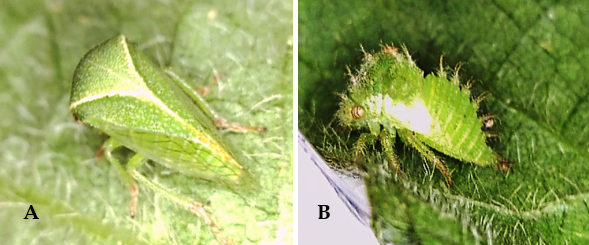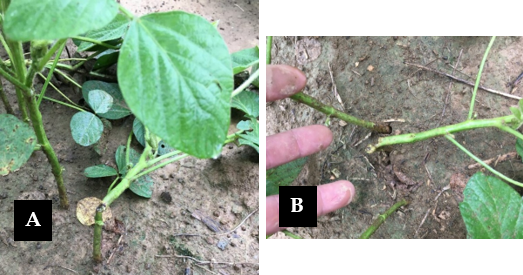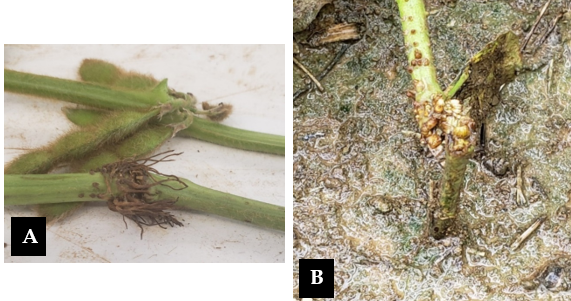Threecornered Alfalfa Hopper in Soybeans
ENTFACT-158: Threecornered Alfalfa Hopper in Soybeans | Download PDF
Raul T. Villanueva, Entomology Extension Specialist
Description
The threecornered alfalfa hopper, Spissistilus festinus (Hemiptera: Membracidae), is about ¼ of an inch long and it gets its name from the triangular body shape of the adult (Figure 1A). It is a common insect pest of alfalfa. Nymphal stages (5 instars) of threecornered alfalfa hopper have very distinctive body shape that resembles the adults, but the dorsal part of their body has saw-toothed spines (Figure 1B). Nymphs are usually found in the lower parts of plants feeding on the stems. In spring, this insect firstly feeds on plants located at the edges of fields and then moves inside the field. This insect is well distributed in the U.S., and it can be found from the Gulf states to Canada.
Hosts and Damage
Threecornered alfalfa hopper has a long list of hosts: cowpea, clover, sugarcane, potato, cotton, sunflower, tomato, and some grasses, herbs, and weeds. However, legumes are the preferred hosts. It is considered an economic pest of alfalfa, soybean and peanut.
Adults and nymphs feed by inserting their piercing mouthparts and sucking up sap from phloem tissue. Feeding usually occurs on main stem, and to a less extent on branch or petiole, where multiple punctures circle the periphery of attacked stem causing girdling due to necrosis of tissue at the feeding site. Enlargement of the stem, on the top of the girdle, appears as a gall (Figures 2A and 2B) with or without formation of aerial adventitious roots and callouses caused by their feeding (Figure 3A and 3B). These injuries debilitate plants, which become susceptible to lodging and stem break off due to mechanical forces, storms, or plants’ weight.
Figure 1. Threecornered alfalfa hopper: A. Adult and B. Nymph. (Photos: Raul Villanueva, UK)
In soybeans, this insect has been considered a sporadic pest, but when outbreaks occurred, plant stands can be reduced and a subsequent yield loss (Figures 2 and 3). Research has been determined that economic yield loss occurs when threecornered alfalfa hopper attacks plants below 10 in tall. When attack takes place in plants taller than 10 in, yield is not affected. Petiole feeding may not cause substantial damage.
Figure 2. (A) Soybean plants lodged or (B) cut off at the necrotic feeding site caused by threecornered alfalfa hopper. (Photo: Gregory Drake, UK)
Life Cycle
In Kentucky, this insect overwinters as an adult in sheltered areas or as eggs in protected plant tissues. In winter, adults (1/4 inch long) live under plant debris and become active when temperatures increase in April or May. The number of generations per soybean season is 2-3, with 220 offspring per female. Adults become active during warm periods in winter. This insect moves from other crops or weeds into soybean in May and June. Life cycle varies with temperature. Egg development takes between 7-10 days at 88⁰ F.
In soybean, six eggs are usually laid in a slit under the epidermis close to the stem base, which occurs early in the growing season. After eggs hatch, nymphs begin to actively feed.
Threecornered alfalfa hoppers have 5 nymphal stages and complete all stages in 8 to 13 days. Two generations usually occur in soybean, with three peaks during the growing season: overwintered adults entering the field in spring, first generation adults within the field and second-generation adults that will leave the field.
Figure 3. Advanced symptoms of threecornered alfalfa hopper attack in soybeans: (A) Aerial adventitious roots developed above feeding site of threecornered alfalfa hopper in soybeans. (B) Lodged soybean plant. Notice the callus caused by the feeding of the threecornered alfalfa hopper (Photo: Raul Villanueva, UK).
Pest Management
As threecornered alfalfa hopper is a sporadic pest in soybeans, a threshold has not been established in Kentucky. However, cultural practices, such as weed management around soybean fields can be effective to reduce threecornered alfalfa hopper populations. There is not an established rule for insecticide treatment for hoppers. Sweep netting (15-inch diameter sweep net) is recommended to tally this insect. The sampling should be conducted in different parts of the field by walking a ‘W’ pattern in 8 to 12 sites of the field. In Louisiana, if plants are setting pods, a treatment threshold of three nymphs per row foot or one adult threecornered alfalfa hopper per sweep net is recommended in soybeans.
Yield reductions ranging from 5.9 (354 lbs.) to 17.6 (1061 lbs.) bushels per acre were associated with late season populations ranging from 48 to 477 adults per 100 sweep net, respectively.
Additional Information
- Threecornered Alfalfa Hopper https://soybeans.ces.ncsu.edu/three-cornered-alfalfa-hopper/
- Soybean Insects. Threecornered Alfalfa Hopper. University of Tennessee. Extension W 201
- Sparks, Jr., A. N., and L. D. Newsom. 1984. Evaluation of the pest status of the threecornered alfalfa hopper (Homoptera: Membracidae) on soybean in Louisiana, Journal of Economic Entomology, 77:1553–1558
- A comprehensive Guide to Soybean Management in Kentucky
Issued: 05/22
CAUTION! Pesticide recommendations in this publication are registered for use in Kentucky, USA ONLY! The use of some products may not be legal in your state or country. Please check with your local county agent or regulatory official before using any pesticide mentioned in this publication.
Of course, ALWAYS READ AND FOLLOW LABEL DIRECTIONS FOR SAFE USE OF ANY PESTICIDE!



